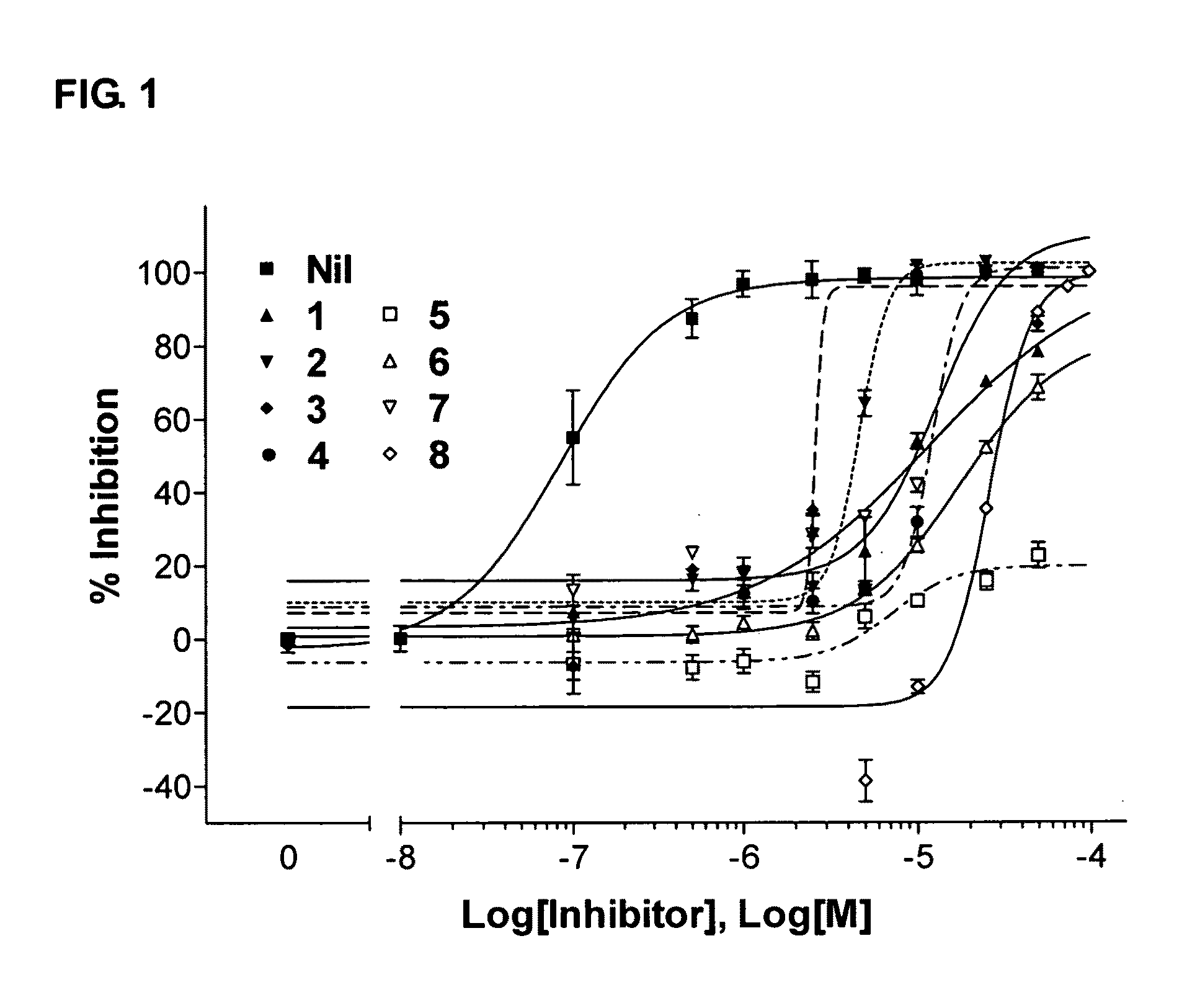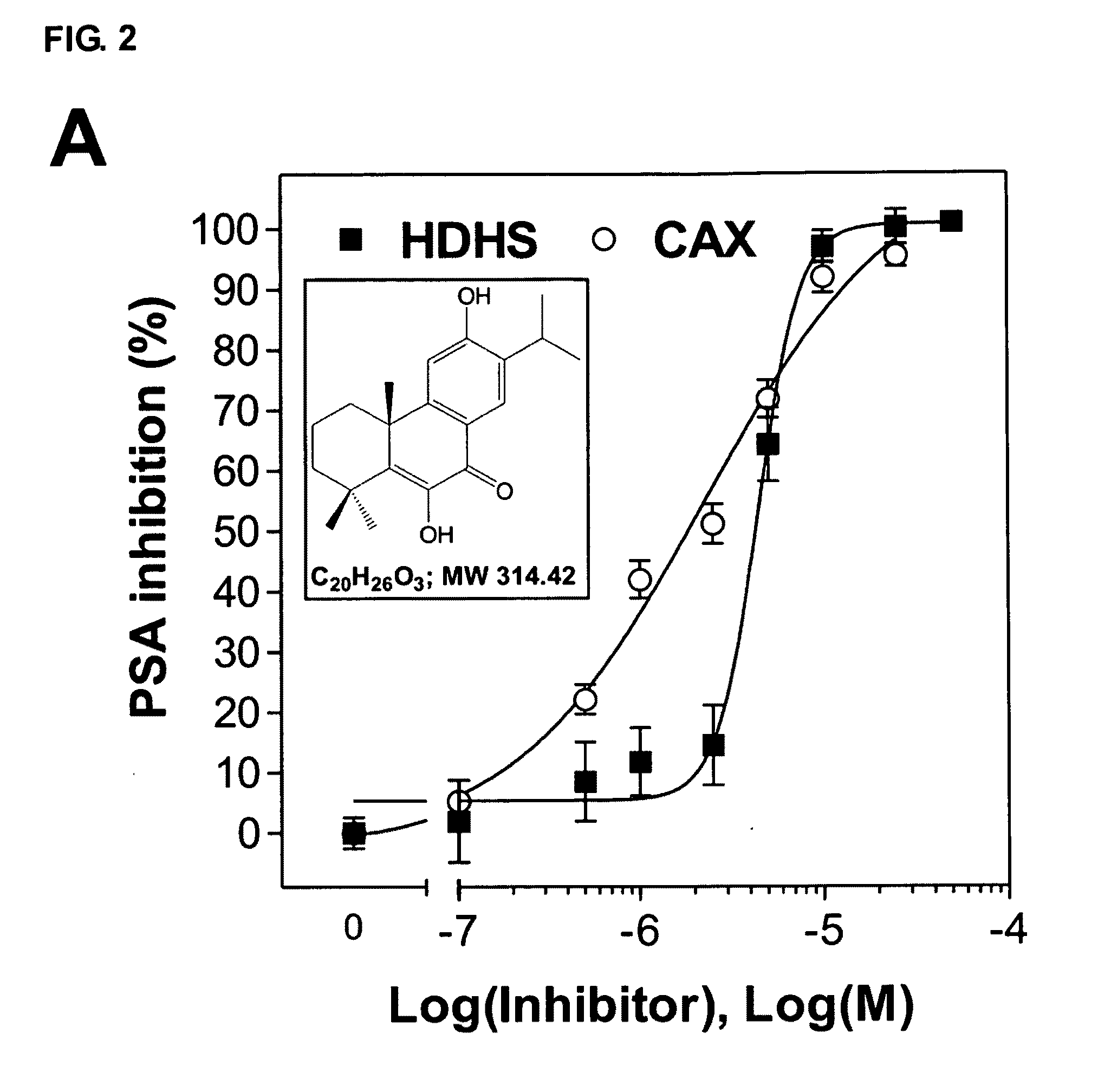Use certain diterpene compounds in the treatment of androgen receptor-associated diseases
a technology of androgen receptors and diterpenes, applied in the direction of heterocyclic compound active ingredients, biocide, drug compositions, etc., can solve the problems of tumor metastasis, and achieve the effect of reducing ar activity and inhibiting ar activity
- Summary
- Abstract
- Description
- Claims
- Application Information
AI Technical Summary
Benefits of technology
Problems solved by technology
Method used
Image
Examples
example 1
Isolation of Diterpene from Cryptomeria japonica
[0070]C. japonica trees were collected from Nan-Tou County, Taiwan, during spring 2005. The air-dried leaves (14.1 kg) and bark (40.2 kg) of C. japonica were crushed and extracted with 70% ethanol (100 L×2) at room temperature for 7 days. The extract was evaporated in vacuo (Rotavapor R200, BÜCHI, Switzerland) to yield a residue (leaf, 1.0 kg; bark, ˜1.2 kg) which was suspended in 20% methanol with water. Then an aliquot of leaf extract (60.9 g) and bark extract (52.4 g) were partitioned sequentially with hexane, ethyl acetate or n-butanol (1000 mL×3, 24 h each). Among all extracts, the ethyl acetate fraction of leaf extract (8.3 g) and the hexane fraction of bark extract (4.9 g) exerted significant inhibition of AR activity and were thus subjected to further investigation.
[0071]Compounds 1 to 8, as described above, were purified using semipreparative HPLC (Agilent 1100 series system, Palo Alto, Calif.) on a C18 Cosmosil column (part...
example 2
Cell Culture
[0072]LNCaP, PC-3, and 22Rv1 PCa cell lines were obtained from the ATCC (Manassas, Va.). Normal fibroblast NIH-3T3 cells were kindly provided by Dr. Lie-Fen Shyur but are also available from the ATCC. The 103E cell line was derived from 22Rv1 and contains a stably transfected PSA promoter luciferase reporter, which expresses in an androgen-dependent manner as previously described (Lin F M et al., Carcinogenesis 2007; 28:2521-9). Specifically, PSA-Luc expression could be induced in 103E cells by androgen at physiological concentration (10 nM DHT) and could be blocked by increasing dosage of an anti-androgen such as nilutamide (Nil) or bicalutamide (a clinically used antiandrogen with the brand name CASODEX). LNCaP, 22Rv1 and 103E cells were cultured in RPMI 1640 medium (Invitrogen, Carlsbad, Calif.) supplemented with 10% fetal bovine serum (FBS; Hyclone, Logan, Utah). PC-3 and NIH-3T3 were cultured in DMEM (Hyclone) supplemented with 10% FBS. Cultures were maintained in ...
example 3
Diterpenes 1 to 8 Inhibit Androgen Receptor Transcriptional Activity in Prostate Cancer Cells
[0073]To study the ability of diterpene Compounds 1 to 8 to inhibit androgen receptor in prostate cancer cells, 103E cell lines as described in Example 2 were used. Cells were treated with various compounds for a period of 20 h and luciferase activity was measured using a luciferase reporter gene assay system (Promega). Results (FIG. 1) indicated that compounds 2, 3, 4, and 7 completely in inhibited AR activity at concentrations below 25 μM. Compounds 1 and 6 inhibited approximately 70% of AR activity at 50 μM. Compound 5 inhibited less than 20% of AR activity at 50 μM and thus its IC50 was not determined (ND). The IC50 of compound 8 (the only labdane diterpene reported here) for suppressing AR activity was 22.7 μM, with 87% inhibition observed at a concentration of 50 μM. Statistical analysis in Table 1 showed significant differences between each diterpene compound and the vehicle control...
PUM
| Property | Measurement | Unit |
|---|---|---|
| weight | aaaaa | aaaaa |
| particle size | aaaaa | aaaaa |
| particle size | aaaaa | aaaaa |
Abstract
Description
Claims
Application Information
 Login to View More
Login to View More - R&D
- Intellectual Property
- Life Sciences
- Materials
- Tech Scout
- Unparalleled Data Quality
- Higher Quality Content
- 60% Fewer Hallucinations
Browse by: Latest US Patents, China's latest patents, Technical Efficacy Thesaurus, Application Domain, Technology Topic, Popular Technical Reports.
© 2025 PatSnap. All rights reserved.Legal|Privacy policy|Modern Slavery Act Transparency Statement|Sitemap|About US| Contact US: help@patsnap.com



